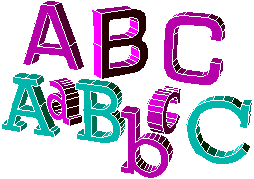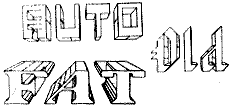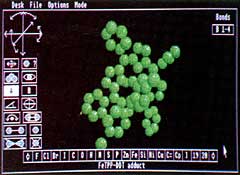Other related products
In the interest of completeness, there were several other products that were more or less closely related to the Cyber products. The following is a list of those not elsewhere described:
3D-Fonts I

Originally titled “Fonts, Primitives, Hints and Tips”; this product by Tom Hudson was actually introduced for CAD-3D 1.0 and contained a couple of sets of 3D font objects (generic serif and sans-serif letters), as well as an assortment of new solid primitives (which mathematician Ian Chadwick helped out on), and some “expert tip” documentation. Tom also threw in the utility “Super Extruder” that could create extrusions out of nested polygons (forms with holes in them, such as the letters “o” and “q”). Tom had written the Super Extruder specifically to make the fonts, and it went on to be the basis for Cyber Sculpt.
3D-Fonts II

This was a second collection of more stylized 3D font objects for CAD-3D, executed by artist and cartoonist Doug Thomas.
Genesis: The 3D Molecular Modeler

Genesis was a remarkable chemistry application by Scott Legrand that could generate a 3D model of pretty much any conceivable molecule. Genesis took advantage of the StereoTek 3D glasses, enabling the user inspect the model in real 3D. Genesis could also export the models in CAD-3D format for animation purposes.
3D Developers Disk for Cyber Studio
Tom Hudson designed CAD-3D 2.0 to be extensible through an Atari ST-centric API. This product comprised documentation and sample code for programmers wishing to tap into CAD-3D. It is unknown who, beyond Tom himself and Mark Kimball, actually made use of this API, but we have included the documentation here for anyone curious about what it was like. Tom has graciously provided the main documentation from this disk for reproduction here in the event somebody is curious about the particulars of the CAD-3D API: click here for Stereo CAD-3D 2.0 Communication Pipeline Specification (text file—160KB)
3D Plotter & Printer Drivers
Tom built into CAD-3D a print feature for producing high-resolution hardcopy of CAD-3D wireframe and shaded scenes. This product comprised a set of drivers for an assortment of popular (for those who could afford such things) plotters and printers of the day. For examples of output from this software, see the blueprints in the Future Design, Architectural Design, Human Design and Microbot Design Disk section.
Anti-aliaser

Tom wrote a little desk accessory “plug-in” for CAD-3D 2.0 that would attempt to anti-alias (smooth out the stair-step “jaggies” inherent in low-resolution computer graphics) rendered images. This product waited until CAD-3D had finished rendering an image, then it jumped in and performed pixel-averaging in high-contrast areas of the screen. The effectiveness of the algorithm was limited absolutely by whatever color palette the user had set up. Most of the Quicktime animations in the Quicktime Gallery were processed by Anti-alias. Tom sold this product himself by mail for $25.
G.I.S.T. G.I. Sound Tool
This Antic application, written by Lee Actor and Gary Levenberg, was a sound synthesis program written specifically for the (rather limited) audio chip built into every Atari ST. The software provided a graphical interface and sound tools that reflected ANALOG synthesis concepts. Cybermate was capable of playing G.I.S.T. sounds in synch with CAD-3D animations. For examples of this integration, please see the Cyberscape and Spider Patrol QuickTime files in the Quicktime Gallery and Cybermate pages.
Application Programming Interface (API)
A feature of a program that enables another program to communicate with and control it.
Desk Accessory
Different operating systems have used different approaches to managing types of programs that hang around (“stay resident”) while the user is working with an application. Often these co-existing programs are intended to complement applications in some fashion. In the Atari ST’s TOS operating system, such programs were called “Desk Accessories”, because they were often accessed from a drop-down menu on the desktop display. The comparable feature of a modern operating system is a “service” or “daemon”.